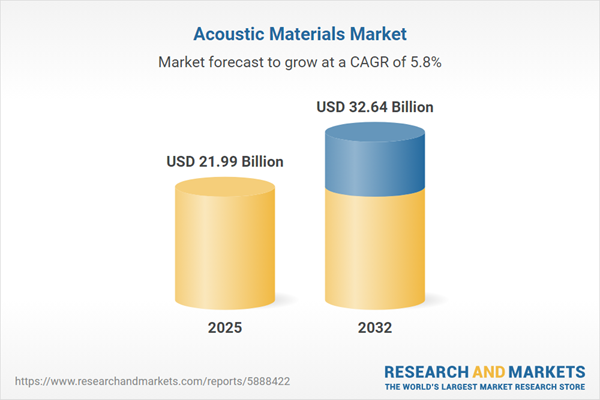Speak directly to the analyst to clarify any post sales queries you may have.
The acoustic materials market is becoming increasingly vital for organizations seeking to align with regulatory demands, drive operational agility, and stay ahead of evolving noise control challenges. Senior stakeholders now view sound management not only as a compliance necessity but as a lever for efficiency, innovation, and resilience across competitive industries.
Market Snapshot: Acoustic Materials Market Growth and Forecast
The global acoustic materials market is forecast to grow from USD 20.79 billion in 2024 to USD 21.99 billion in 2025, ultimately reaching USD 32.64 billion by 2032. This trajectory reflects a compound annual growth rate (CAGR) of 5.79%. Key market drivers include advances in material science, enhanced sound technologies, and the integration of sustainability practices within procurement strategies. As organizations adapt to stringent noise regulations and sector-specific requirements, they are redesigning supply chains and sourcing models. These changes support the adoption of customized solutions, helping businesses meet emerging lifecycle and operational targets in their core industries.
Scope & Segmentation of the Acoustic Materials Market
- Product Types: Lightweight foams, including melamine and polyurethane, help reduce noise in construction, automotive, and industrial environments. Rigid and sandwich panels offer both sound absorption and structural reinforcement, suited for high-performance settings.
- Material Types: Mineral wool—rock and glass—delivers fire-resistant and sound-insulating properties. Advanced polymers like polyurethane and PVC combine versatile installation with thermal efficiency, supporting their use in various sectors.
- Applications: Automotive firms use acoustic materials to optimize passenger experience and limit vibration. Construction companies incorporate them for regulatory compliance. Customized solutions support specific needs in healthcare, education, and hospitality, enhancing user comfort and adherence to local standards.
- End Users: Commercial facilities such as offices, hotels, and schools prioritize both occupant satisfaction and regulatory obligations. Residential applications focus on lifestyle upgrades and integration into architectural design, meeting growing demands from homeowners.
- Distribution Channels: Established distributors and digital procurement channels provide extensive reach, allowing companies to implement agile sourcing strategies tailored to unique operational priorities.
- Regional Coverage: Key regions include the Americas, Europe, Middle East & Africa, and Asia-Pacific. Regulatory frameworks and local requirements encourage organizations to develop region-specialized supply chains and operational tactics for sustained competitiveness.
- Technologies: Nanotechnology advances and engineered microstructures drive improvements in acoustic absorption and material durability. Additive manufacturing allows for customized product design. Predictive analytics and digital management tools support efficient deployment and ongoing resource monitoring for maximum value.
- Major Companies: Industry participants include Owens Corning, Knauf Insulation GmbH, Rockwool International A/S, Saint-Gobain S.A., BASF SE, Johns Manville Corporation, Armstrong World Industries, USG Corporation, Kingspan Group plc, and Recticel N.V.
Key Takeaways: Strategic Insights for Senior Stakeholders
- Composite innovations facilitate reliable sound management across diverse and demanding operational settings, enabling organizations to meet industry-specific challenges.
- Digital collaboration is accelerating product development cycles, providing faster alignment with shifting regulatory requirements and supporting strategic adaptation.
- Integrated solutions that combine acoustic insulation, fire protection, and thermal performance simplify facility management for stakeholders overseeing complex sites.
- Developing regionally tailored compliance strategies builds trust among regulatory bodies and supports smooth market entry or expansion where regulations vary significantly.
- Expanding and diversifying supplier relationships helps mitigate the impact of unpredictable supply chain disruptions, allowing organizations to maintain business continuity.
- Streamlined procurement processes and digital sourcing platforms enhance flexibility, giving stakeholders rapid access to certified materials and enabling agile responses to project demands.
Tariff Impact: Navigating US Tariff Disruptions
The recent introduction of US tariffs on imported acoustic materials is influencing sourcing decisions across sectors. Organizations are increasing investment in domestic manufacturing and reinforcing supplier networks, which is essential for sectors like automotive and construction. These proactive measures ensure supply continuity and compliance as trade regulations and international sourcing rules shift.
Methodology & Data Sources
Insights in this report are based on comprehensive secondary research, targeted industry surveys, and interviews with subject matter specialists. Data is validated through established market databases, peer-reviewed sources, and scenario analysis to provide actionable information for decision-making.
Why This Report Matters
- Equips executive teams with frameworks for managing regulatory changes and refining risk mitigation strategies in response to evolving noise control standards.
- Presents robust segmentation and technology insights to support procurement decisions and optimize capital deployment, ensuring long-term value extraction.
- Promotes readiness for sector shifts by providing up-to-date market developments, encouraging proactive responses to emerging operational challenges.
Conclusion
This report empowers executives to make informed, strategic choices, supporting agile and compliant approaches to utilizing acoustic materials for lasting organizational resilience and sustainable growth.
Additional Product Information:
- Purchase of this report includes 1 year online access with quarterly updates.
- This report can be updated on request. Please contact our Customer Experience team using the Ask a Question widget on our website.
Table of Contents
3. Executive Summary
4. Market Overview
7. Cumulative Impact of Artificial Intelligence 2025
Companies Mentioned
The companies profiled in this Acoustic Materials market report include:- Owens Corning
- Knauf Insulation GmbH
- Rockwool International A/S
- Saint-Gobain S.A.
- BASF SE
- Johns Manville Corporation
- Armstrong World Industries, Inc.
- USG Corporation
- Kingspan Group plc
- Recticel N.V.
Table Information
| Report Attribute | Details |
|---|---|
| No. of Pages | 195 |
| Published | October 2025 |
| Forecast Period | 2025 - 2032 |
| Estimated Market Value ( USD | $ 21.99 Billion |
| Forecasted Market Value ( USD | $ 32.64 Billion |
| Compound Annual Growth Rate | 5.7% |
| Regions Covered | Global |
| No. of Companies Mentioned | 11 |









